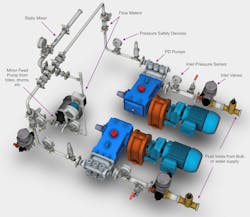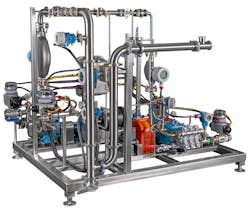Why inline blending beats batch mixing
Conjure if you will the image of factory workers handling drums, totes and pails to manually dump numerous ingredients into a large batch tank on load cells with large horsepower agitators on top.
Drum pumps might be used to transfer liquid material to the tank based on weight addition. Smaller pails of material will be trudged up to the top of the tank and dumped in by hand. A centrifugal or PD transfer pump might be wheeled over and connected to a tote as larger quantity materials are transferred again by weight addition.
Large process manufacturing sites with larger budgets might be more sophisticated with their approach by automating these transfers and will draw from bulk storage versus totes, drums, etc., where possible. These ingredient additions are still dumped one at a time by weight addition. The load cells or floor scales must consider the weight of the tank, so their resolution is typically poor when it comes to smaller ingredient dump amounts, thereby providing poor ratio control among ingredients.
More advanced factories may use expensive mass flow meters to fly in liquid ingredients simultaneously, but without guarantee that the proper amount was dumped, as the flow meters will not consider material left in piping, drain amounts, etc. Typically, process manufacturers’ recipes include large quantities of either water or some bulk ingredient. Transferring water to a batch tank is a wasteful practice, but we will get to that later.
What exactly is inline blending?
As you can see from the description above, batch mixing is confined to a single tank where all the materials are typically added one at a time. This approach has many inherent drawbacks:
- A large costly tank is required.
- The tank(s) consume valuable floor space.
- Ingredients are usually added one at a time.
- Large bulk materials or water are transferred to this tank, consuming valuable space.
- Agitation at large HP is required in the tank.
- Ratio control is not accurate due to low resolution flow scales or load cells.
- More tanks are added, and more floor space is consumed as demand for more capacity grows.
Inline blending systems are used to eliminate these restrictions and flaws. A typical system uses multiple PD pumps with various types of flow meter technologies to simultaneously meter liquid ingredients into a common pipeline with static mixers or an alternate inline shearing device. These PD pumps get connected to bulk storage tanks, totes, drums or factory water supply. PLC automation onboard the skid will start and stop these pumps together and provide PID ratio control for each. Figure 1 illustrates the mechanical concept nicely.
Inline blending systems typically feature their own onboard controls which can be as simple as a PLC by Allen Bradley, Siemens or others, an operator HMI panel and a VFD inverter cabinet. The VFD drives communicate with the motors connected to each PD pump to drive the pump to specific speeds. The flow meters read the resulting flow from the PD pumps and the PLC PID control block compares the actual flow to a target flow and automatically adjusts the motor speed (pump flow rate) via the VFD to track the flow setpoint accurately. Depending on the type of flow meters used — Coriolis mass flow meters by Endress & Hauser and MicroMotion being the most accurate — ratio control can be within 0.25 – 0.35% across two or more feeds.
In the most simplistic sense, every process manufacturer should avoid transferring water to a batch tank. Making a concentrate where possible and using a 2-feed inline blend system to meter the water and the concentrate at ratio is a far better approach. You do still have to contend with some level of batch making vis a vie the concentrated premix, but the process is simplified. It ultimately reduces the amount of water, or other bulk fluid, significantly, allowing more product yield for given tank size. The idea is to expand from there and meter all or as many ingredients as possible.
In the case of windshield washer fluid or non-gel hand sanitizers, for example, there are a finite and low number of liquids to meter from bulk storage and totes, so zero concentrates or premixes are required, and everything is metered from source (totes, drums, bulk storage). In other processes you might not get so lucky as to meter everything because you will have powders to deal with and a premix becomes unavoidable. Again, the focus is on increased product yield for given tank and floor space while reducing tank sizes overall.
The benefits of inline blending
Let us review the numerous advantages of inline blending over conventional batch mixing methods. Moving water or other bulk materials around frequently is wasteful. And moving from bulk to batch tank then from batch tank to hold tank or fillers is also wasteful. Inline blending systems move finished product while mixing on the go, in essence eliminating the middle-man batch mixing tank. This saves process time by reducing transfers and eliminating batch tank agitation times. Also, the larger your batch tanks, the larger the agitator motors. Inline blending systems can meter up to four fluids at 100 GPM total flow at less than 10 HP in some cases.
- Elimination of batch mixing tank.
- Elimination of multiple transfers.
- Increased product yield for any premix tanks used.
- Increased accuracy of ingredient ratio — 0.25-0.35% (flow meter dependent).
- Reduced process cycle times.
- Reduced energy consumption.
There are other considerations, as well. In dealing with flammable fluids, for example, drawing from bulk tanks located safely outside the building allows you to keep the building interior safe and reduce costly fire code issues. In the case of ethanol or methanol in the manufacture of hand sanitizer or windshield washer fluid, the bulk of the material that releases larger quantities of flammable vapors is kept outside. With batch mixing, those materials get transferred inside in large quantities that now render an XP hazard rating inside the building. An inline blending system is a closed system that contains only minor volumes of vapor-releasing liquids inside pumps and piping, which is insufficient to require an XP rating.
Rob Brakeman is the owner/director of Sonic Corp. His company specializes in the custom design and fabrication of high-pressure homogenizer systems and inline blending skids. The company’s flagship homogenizer, the Sonolator, is designed into custom systems that emulsify and disperse a wide range of fluids in all major industries.
Sonic Corporation


